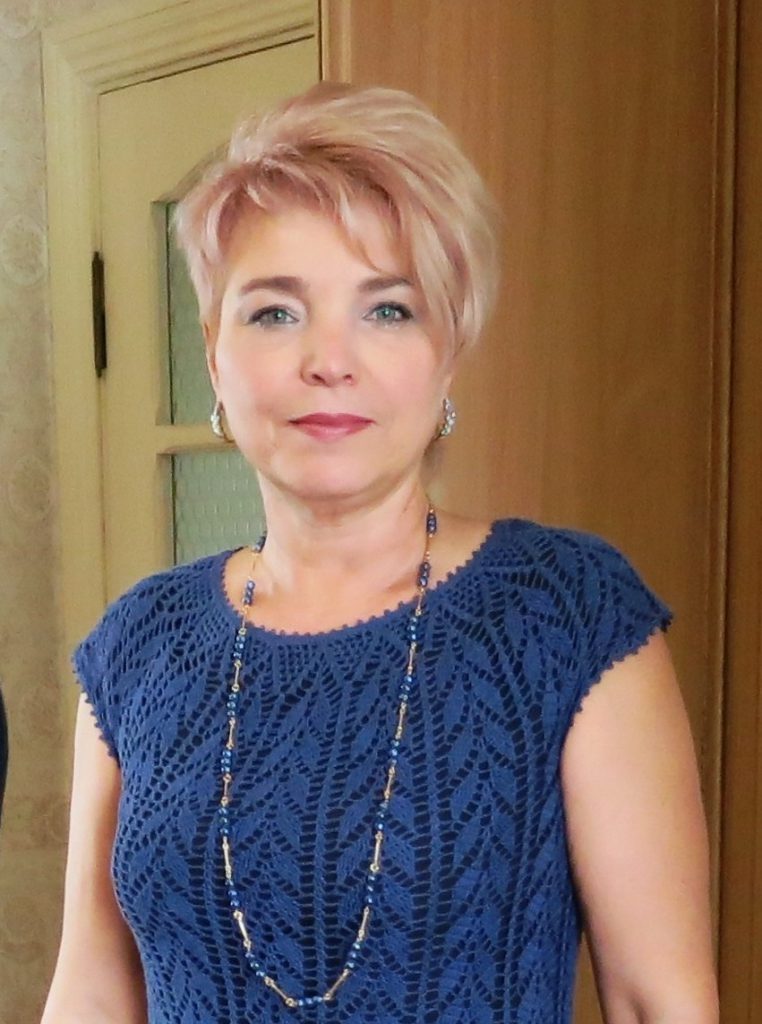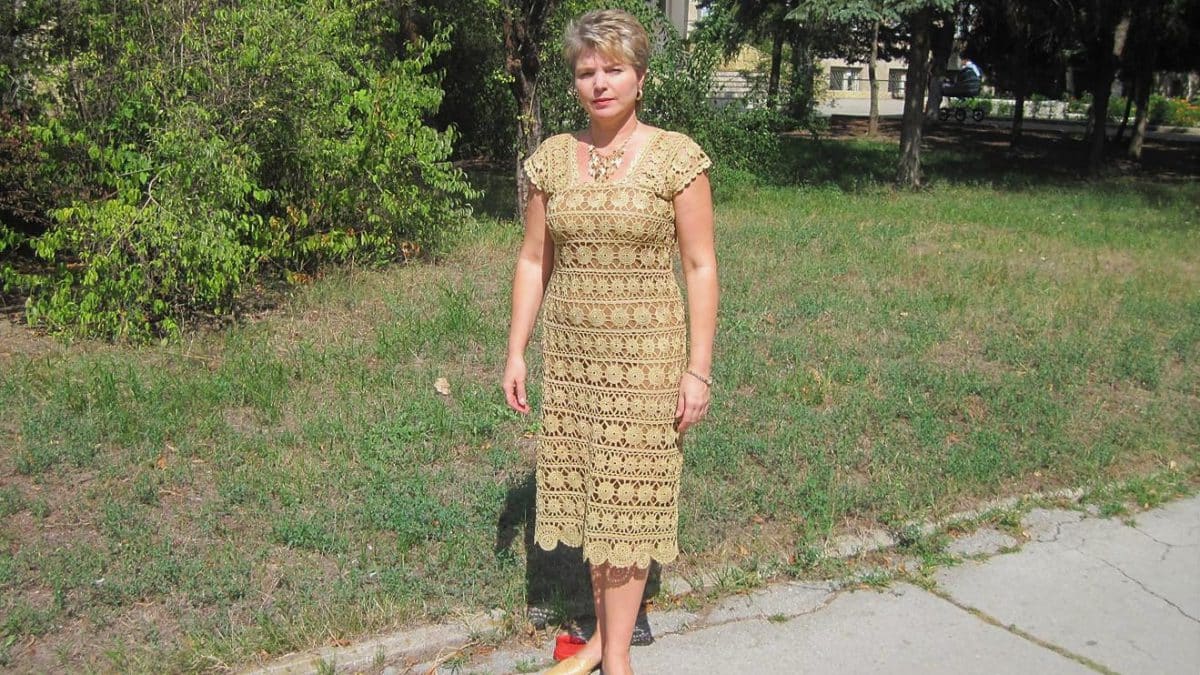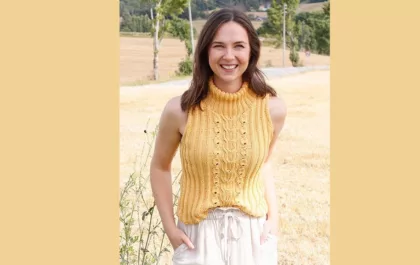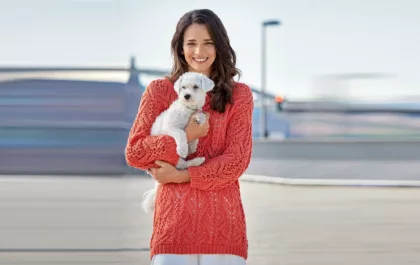Crochet dress from the HOSS online catalog – Gold coins

It took 500g. Turkish yarn “Tulip” (100% microfiber) 500m/100g; Clover hook 1.5mm
We knit a pattern of large and small coins and an intermediate strip between them.

Continuous knitting.
Start each strip of motifs with a new thread.
Big coin:
Row 0 – 10 turns around the pencil
Row 1 – 16 RLS
Row 2 – 16 dc
Row 3 – 32 dc
Row 4 – 48 dc
5th row - tying the SS in a circle and tying petals - picot from every 4th loop (see photo) corner - 14VP, connecting - 5VP, top and bottom - 7VP
When knitting continuously, move on to the next motif 15VP.
An example of knitting large coins on 12 sc in the initial row:
Continuous knitting pattern for large motifs

Having knitted large coins, we move on to the intermediate connecting strip:
6th row - we connect the coins by the upper petals - picot arches of 6-7 VP (see the connection order in the sample photo)
Rows 7,8,9 – RLS in accordance with the number of VPs
Row 10 – arches of 5 VPs for one large motif – 4 arches.
Row 11 – we tie the arches with sc, 5sc in each arch.

small coin
Row 0 – 10 turns around the pencil
Row 1 – 18 RLS
Row 2 - 18 dc
Row 3 – 36 dc
4th row - tying the SS in a circle and knitting petals - a picot from every 3rd loop (see in the photo the number of VPs in a picot: corner - 14 VP, connecting - 5 VP, upper and lower - 7 VP each.
When knitting continuously, move on to the next 12VP motif.
An example of knitting small coins on 12 sc in the starting row.
Continuous knitting pattern for small motifs

Intermediate connecting strip after small motifs:
5th row - we connect the petals - picot with air loops. 5VP in each interval.
Row 6 – 5 sc in each arch
7.8 row – RLS
We wash the sample, dry it, and carefully iron it through gauze. Microfiber does not like high temperatures.
We make calculations based on the number of stripes and motifs in each stripe. The photo shows the number of coins in each strip.

We start knitting a dress with the longest stripes of the skirt.
There are 21 coins in a strip of large motifs - accordingly, there will be arches in the 10th row - 21x4 = 84 arches.
We tie the coins on the other side as well.
We knit a strip of small coins - 28 pieces. To connect to the intermediate strip you need 28x3=84 arches.
Ideal 84/84 connection.
When knitting the 11th row - tying the arches - we attach a strip of small coins.


The photo shows that the connecting intermediate strips are knitted from large coins up and down. When tying the RLS arches, a strip of small motifs is attached.
The number of arches on the skirt was a perfect match. Then a little math, and the stripes will also fit perfectly.
Example calculation for a strip of 20 large gold coins.
To connect with a strip of 28 small coins, you need to get 28 x 3 = 84 arches x 5 = 420p.
To do this, when tying large picoletal motifs, we knit in chains of 7-6-7 VP, 7СБН = 21p. 20 motifs x 21p = 420p
Next we knit 84 arches and connect them with 28 small coins.
On the other side there is a connection with 26 small coins. You need to get 26 x 3 = 78 arches x 5 = 390 p.
To do this, when tying large motifs into chains of 7-6-7 VP, we knit 10 times x 20 sc = 200p; and 10 times x 19 SBN = 190 p. It turns out 390 p: 5 p = 78 arches.
Another calculation can be made. Knit as usual in chains of 20 sc. We get 400p in 20 motifs.
To get 78 arches, we knit 10 times in every 6th sc and 66 times in every 5th sc. 10 x 6 + 66+5 = 390 p.
Wide straps - sleeves knitted from two stripes: 10 small motifs and 8 large ones. Tying a strip of small coins according to the following pattern:
1st row - we connect the petals - picot with air loops. 5VP in each interval.
Row 2 – 5 sc in each arch
3rd row – 3 SS to the middle of the arch of the previous row, then 5 VP arches
4,5,6 row – RLS

Neck and sleeve trim according to the scheme:

The final row of processing is with connecting posts along the edge of the circles and at the same time joining to the edge of the canvas.
Rapport for attaching strips of small motifs – 9 loops.

18 small motifs are knitted along the outer edge of the strap.
Processing the neckline

Internal processing of the neckline with small motifs - 6 small motifs. On the inside of the straps there are 17 motifs, including angular ones.


Decorative hem border

We tie the edge of the hem from a strip with small coins - 28 motifs:
Row 1 – 5 VPs connect picot petals. There are 3 arches for each motif -28 x 3 = 84 arches (84 x 5 = 420 p)
Row 2 – 5 sc in each arch
3rd row – 3SS to the middle of the arch of the previous row, then arches of 5 VP
4,5,6 row – RLS
Row 7 – 81 arch ((15 x 6) + (66 x 5) = 420p)
Row 8 – sc – and adding a decorative border.
The hem of the dress is decorated with a decorative border of 18 circles, knitted according to the pattern:
Border motif diagram


Ribbon diagram for connecting border motifs

Attaching the border to the dress while tying the arches, sc. There are 9 arches for two circles of the border, that is, 81 arches will be required to attach the border. The garter occurs in chains of VP. Six picots from VP: 13 – 7 -5 -5- 7 – 13
Scheme of connecting the border to the hem

The dress is ready. It has a thin tan-colored knitted lining sewn onto it. The lining is fixed along the top line of the dress.
I am also posting a diagram of the motifs and their combination into stripes. Maybe this option will suit someone better.
Scheme of motifs and their combination into stripes


Thank you for watching!
You can see my other models here***
Related posts
About the Author

Welcome !
My name is Lilia. The main hobby of my life is knitting. I started with knitting needles and switched to a knitting machine. In 1988 I got acquainted with crochet - Romanian lace. About 10 years ago I became interested in Irish lace and Shetland knitting. And now I’m trying fillet crochet. On this site I want to share with you my 45 years of experience in various knitting techniques.
Latest publications
Top Race the Wind
Ажурный удлиненный пуловер
Ажурный удлиненный пуловер связанный из 100% биохлопка не оставит равнодушным никого. Сияющий коралловый цвет пленит кого угодно!
Pink crochet cardigan
Blog Subscription
Be the first to receive new items!



